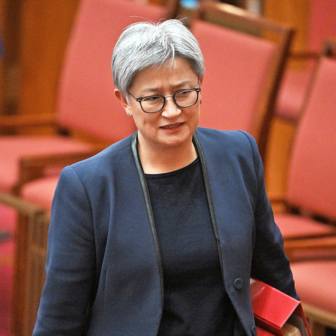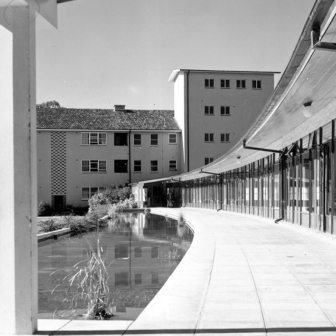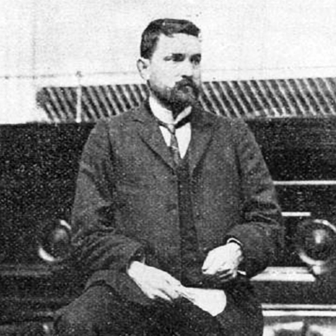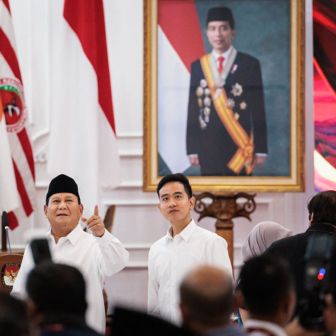The early days of the Covid-19 pandemic hit Canadian prime minister Justin Trudeau as close to home as it’s possible to get. On 12 March his wife, Sophie Grégoire Trudeau, tested positive after returning from a trip to Britain, making her the 158th Canadian to be diagnosed with the disease.
Sophie self-isolated in one section of the prime ministerial home while Justin assumed full responsibility for the household, including the couple’s three children, aged twelve, eleven and six. Meals were delivered, but otherwise the Trudeau family was on its own. Official photos of Trudeau working in his home office and holding conference calls with world leaders were taken by his daughter. He was late for at least one meeting because his son’s bathtime went past schedule.
Sophie Trudeau recovered full health, but it was another peak moment for Justin Trudeau’s progressive and enlightened image: this time, as a regular working dad and temporary single parent.
Initially, Trudeau’s government steered a similarly steady course. While specific public health measures were largely under provincial and local jurisdiction, the national government moved quickly to close the US border to non-essential travel while ensuring vital economic and supply links remained moving. A major economic aid package — including wage subsidies and the Canada Emergency Response Benefit, a direct government transfer of up to C$2000 a month to workers affected by the pandemic — was quickly assembled, and a flurry of other programs responded to the pandemic’s massive disruption.
Trudeau addressed the nation daily, emerging from his front door to give live televised addresses. His reassuring image of sincerity and compassion was well received amid a broad national consensus. Unlike the chaotic polarisation across the border, in Canada politicians of all stripes broadly agreed on responses to the pandemic. Cracks and problems emerged, of course, with reports of how successive governments had overlooked warnings to prepare for such a crisis, especially by stockpiling personal protective equipment. Overall, though, Canada and its prime minister could pat themselves on the back for handling the pandemic pretty well.
Then events took a different turn. On 25 June the government announced yet another new program, the Canada Student Service Grant, an initiative to encourage volunteer service through funded placements. Unlike other pandemic response programs, though, this would be run externally, by an organisation called the WE Charity.
Led by two charismatic brothers, Craig and Marc Kielburger, WE was among the highest-profile charities in the country. Working through schools and holding massive “WE Day” arena rallies, it had built partnerships with major corporations and news outlets, including the nation’s biggest bank, the Royal Bank of Canada, top telecom provider Telus, the Canadian arm of KPMG, and the national Globe and Mail newspaper. The Kielburger brothers were national celebrities, especially Craig Kielburger, who had founded the initial organisation in 1995 as a precocious twelve-year-old.
Yet the announcement drew immediate scepticism. Governance experts and public servants asked why an external partner was needed when the government had shown it was able to create and deliver massive new programs like the Emergency Response Benefit in weeks. What made WE best suited to the job?
For its part, the opposition pounced on Trudeau’s personal connections with the charity. He had appeared at WE rallies as prime minister, and so had several of his family members. Revelations soon emerged that his mother, the indomitable Margaret Trudeau, had spoken at quite a few WE events, receiving C$250,000 in expenses and honorariums. Brother Sacha Trudeau had also been engaged for C$32,000. Even Sophie Trudeau’s fateful trip to Britain, where she attended a WE event as part of its growing global portfolio, was expenses-paid by WE.
The backlash was swift. Just over a week later, on 3 July, the arrangement with WE was terminated. But that didn’t stop the scrutiny from intensifying.
WE and the Kielburger brothers didn’t fare well. Despite many years of high-profile operations and a sparkling reputation for upbeat goodwill, the organisation proved to be more complicated than most people imagined. While WE itself was a charity, other arms of the Kielburgers’ empire didn’t have charitable status, its accompanying “ME to WE” unit was expressly for-profit, and financial arrangements between the entities were complex.
Originally focused on international development, WE now spanned many activities, foreign and domestic. In the words of one analysis, “it defies easy description, from its high school clubs to international development projects to ethical chocolate sales to mental health advocacy.” Revelations about difficult workplace conditions, and the news that the chair of the WE board had resigned in March under pressure from Craig Kielburger were highly damaging.
The Kielburgers had also been a litigious duo. Notwithstanding WE’s partnerships with most newspapers in the country, it emerged that they frequently challenged negative coverage of their organisations and activities. Deep scrutiny had largely been left to the alternative press.
Parliamentary committees launched investigations into the affair, with the finance committee taking the lead in seeking answers to two questions. Had public servants been directed to favour WE in the design of the program? And to what extent had Trudeau and others recused themselves from decisions related to WE? The muddled answers, when they came, demonstrated just how far the WE empire had permeated the Canadian establishment.
Public servants testified, somewhat convincingly, that they had turned to WE without political interference or pressure because it was the only suitable entity to deliver the program. But a later-revealed email from one senior public servant describing WE executives and political staff of the finance minister as “besties” didn’t engender confidence in the arm’s-length nature of the process.
Finance minister Bill Morneau’s testimony dug the hole deeper. Although he had recused himself from the development of the WE scheme because his daughter worked for the organisation, he had participated in the cabinet discussions that approved it. Then he revealed that he and his family had taken trips to Kenya and Ecuador to visit WE projects, and that he had unintentionally failed to repay the charity the C$41,000 cost, an oversight he had corrected the day before his testimony. This, to put it mildly, was not well received.
The Kielburgers themselves testified for what is generally considered a disastrous four hours, during which they were highly defensive and failed to gain public sympathy.
The peak of the affair came on 30 July when Trudeau appeared before the finance committee, the first prime minister to be quizzed by a parliamentary committee on his own conduct since 1932. The opposition focused on the Trudeau family’s connections to WE, and Trudeau outlined his own recusal from the WE decision. He pointed out that his wife’s London trip had been approved by the ethics commissioner and said that he had excluded himself from development of the Student Service Grant. But he was less able to explain the rest of his family’s connections — or why, like Morneau, he participated in the final cabinet discussions of the arrangement.
The ethics commissioner announced an inquiry into the issue and the prime minister’s conduct. This is the commissioner’s third inquiry into Trudeau as prime minister, after earlier findings that Trudeau violated conflict-of-interest provisions in his use of the Aga Khan’s private aircraft and vacation island, and that he put improper pressure on government officials to cut a prosecution deal with a major Montreal employer, SNC-Lavalin, over foreign corruption issues.
Once again, the central issue was Trudeau’s judgement. Even if there was no evidence of egregious corruption, the prime minister didn’t appear to have thought through how his actions could be perceived. This falls into a longstanding pattern that includes his infamous appearances in blackface as a young adult. Trudeau has always stood for good intentions — but intentions not always well thought-out.
Like Trudeau, the Kielburger brothers had built high-profile careers on good intentions, personal charisma, a brand of pleasant but vague and unthreatening progressiveness, and well-groomed hair and good teeth. Yet Trudeau’s case was assisted by the fact that he wasn’t the only person drawn into their web. The implosion of WE was a sad indictment of the entire Canadian corporate and media establishment, which had happily backed a winning brand for years without looking too closely.
This general complicity masked the odour of Trudeau’s own connections to the rapidly collapsing entity. Its corporate partners fled, and on 10 September WE announced the cessation of its Canadian operations.
The political hit was bad but not catastrophic. Trudeau’s approval ratings, which had hit a modest high of 55 per cent in the northern spring, fell to 44 per cent at the height of the scandal in late July. The Liberals retained a slight polling lead over the Conservatives, who were concluding a laborious leadership election that had been extended to eight months by the pandemic. Nevertheless, Yves-François Blanchet, the leader of the third-party Bloc Québécois, pledged to seek a no-confidence vote when the hung parliament resumed in autumn.
In the meantime, Trudeau had set about cleaning up. Tensions between him and the finance minister over the pace of government spending in the pandemic — no doubt made worse by Morneau’s embarrassing part in the WE mess — appeared to culminate on 17 August when Morneau unexpectedly announced his retirement from politics. Trudeau immediately replaced him with the formidable deputy prime minister, Chrystia Freeland, who had previously served as international trade, foreign, and intergovernmental affairs minister. Freeland is widely seen as the government’s fixer, assigned to tough jobs like negotiating a revised free-trade agreement with the Trump administration.
A day later, Trudeau announced that parliament would be prorogued for a month. This would allow a “reset” of the government’s agenda to deal with the realities of 2020, he said, playing down the fact that it also dissolved the parliamentary committees still digging into the WE affair. Sudden prorogation to escape inconvenient political situations (an option denied to Britain’s Boris Johnson last September by the UK Supreme Court) has become a familiar tactic in Canada, even though Trudeau’s 2015 party platform pledged not to use the mechanism “to avoid difficult political circumstances.”
Five days later, the Conservatives elected a new leader, Erin O’Toole. Having run for eight months as an upstart “true blue” Conservative against the slightly more moderate frontrunner, Peter Mackay, O’Toole changed his tone on leadership election night and pledged an inclusive party for all, posing a potentially much stronger threat than his lacklustre predecessor Andrew Scheer, and at least modestly infringing on the Trudeau brand.
And so, as August ended and the northern hemisphere autumn approached, there was optimism in Canadian politics, alongside serious talk of an election. Covid-19 conditions appeared stable and Canadians had enjoyed a socially distanced summer with no new lockdowns. Trudeau had declared that the governor-general’s 23 September speech to parliament (known in Canada as the throne speech) would be a “road map out of the pandemic” that would enable Canada to “build back better.” Grand policy designs were rumoured along with discussion of Trudeau’s election prospects against the novice O’Toole.
But September was a different story. The beginning of the Canadian school year was chaotic, especially in Ontario, where teachers and parents were bewildered and upset by unclear and shifting policies. While this was outside federal jurisdiction, it demonstrated that stability was still far away.
Then unmistakable evidence emerged that the dreaded second wave was arriving. Covid-19 cases began to rise again, and demands for tests far outstripped capacity. Again, much of this was under provincial jurisdiction, out of Trudeau’s direct responsibility, though provincial governments begged for more federal funding to bolster their healthcare systems. But news also emerged that Trudeau’s own government had in the previous years refocused a renowned unit responsible for monitoring global health risks, which might otherwise have given better early warning of the pandemic.
Finally, both Conservative leader O’Toole and Bloc Québécois leader Blanchet tested positive for Covid-19 and went into self-isolation (neither has developed symptoms). Amid this misery, expectations for the throne speech were curbed, as was talk of an election. The airwaves were instead dominated by renewed pleas from public health authorities for Canadians to stay vigilant, and by the continuing furore over schools and testing capacity.
Trudeau briefly ramped up expectations by asking for television time to address the nation on the evening of 23 September, following that afternoon’s throne speech. Each of his three predecessors had done this exactly once, to address pressing constitutional or parliamentary crises. But Trudeau’s address was anti-climactic, largely repeating the themes and promises in the speech read by the governor-general hours before.
Standing amid Canadian flags and looking very prime ministerial, Trudeau outlined a sprawling plan that promised new support for provincial testing; ongoing wage and income-support programs; a million new jobs; national child care and pharmacare programs (both already long promised); investments in electric vehicles; measures to tackle systemic racism; and much more. The overall themes were nevertheless clear: first, that the government was prepared to continue spending and intervening in the economy to deal with the pandemic; second, that it remained committed — at least in words — to a progressive agenda, taking a “feminist, intersectional response” to the pandemic (words used in the throne speech but not by Trudeau in his television address).
Six months after the pandemic was declared, Trudeau appears back where he started, as the well-meaning, progressive-sounding leader who ran the country and his household briefly as a single parent, and who, like the Kielburger brothers, exudes good intentions that aren’t always realised in practice. The resumption of parliament will likely mean renewed committee inquiries into the WE affair, and the ethics commissioner’s eventual report will be added to the shelf of inquiries into Trudeau misjudgements.
But WE is unlikely to do much further political damage, and overall Canada remains well-off. The second wave is now of top concern, but the country has so far escaped any major new lockdowns. Life and the economy remain greatly disrupted, but public consensus remains strong, with masks and social distancing widely accepted in principle, if not always in practice. And the Canada–US border stays closed, isolating Canadians somewhat from the chaos to the south, while the country and its prime minister keep afloat, luckily on more than just good intentions. •




